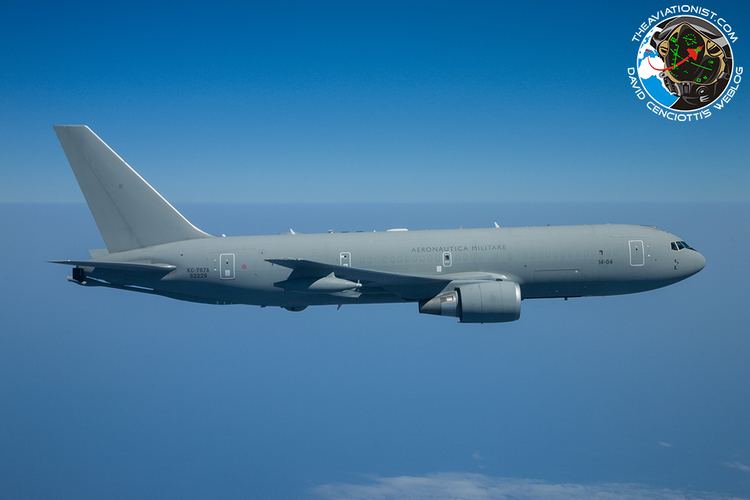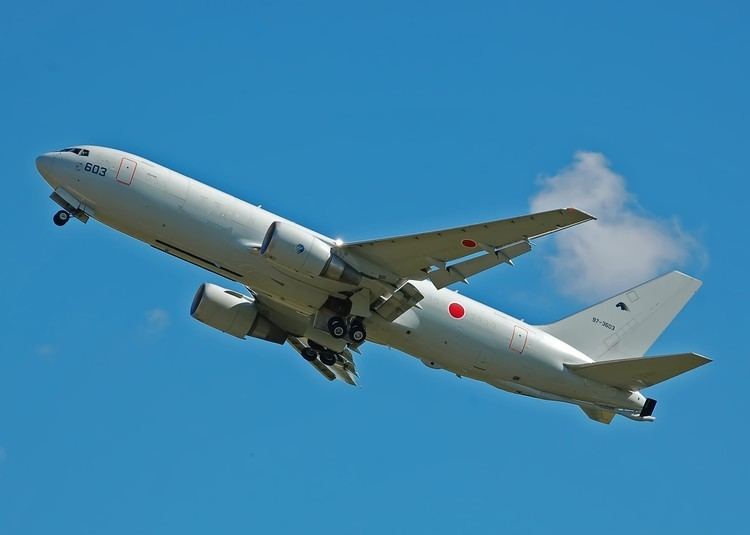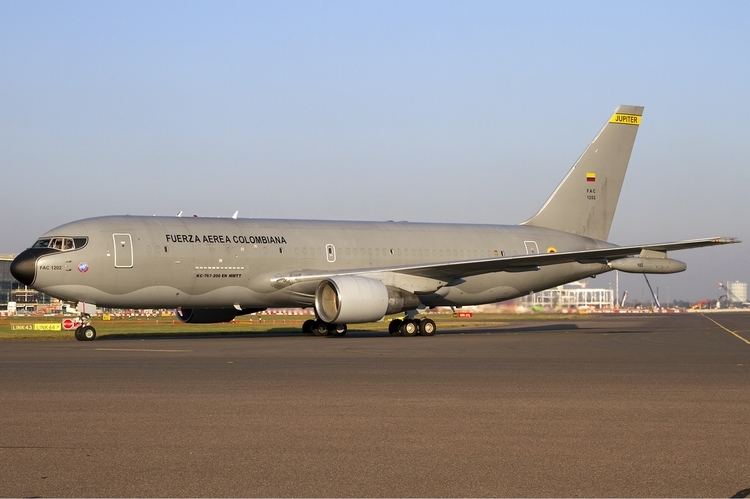Top speed 915 km/h Length 49 m Cruise speed 851 km/h | Range 12,325 km Wingspan 48 m Engine type General Electric CF6 | |
 | ||
Unit cost 145,000,000–145,000,000 USD | ||
The Boeing KC-767 is a military aerial refueling and strategic transport aircraft developed from the Boeing 767-200ER. The tanker received the designation KC-767A, after being selected by the U.S. Air Force (USAF) initially to replace older KC-135Es. In December 2003, the contract was frozen and later canceled due to corruption allegations.
Contents
- Commercial Derivative Air Refueling Aircraft
- USAF lease cancellation and re award
- Italian Air Force
- Japan Self Defense Forces
- Others
- USAF KC X Program
- Flight testing
- Variants
- Israeli tanker conversions
- Operators
- Specifications KC 767
- References

The tanker was developed for the Italian and Japanese air forces, who ordered four tankers each. Financing of the development of the aircraft has largely been borne by Boeing, in the hope of receiving major orders from the USAF. Boeing's revised KC-767 proposal to the USAF was selected in February 2011 for the KC-X program under the designation KC-46.
Commercial Derivative Air Refueling Aircraft

The USAF ran a procurement program to replace about 100 of its oldest KC-135E Stratotankers, part of the "Commercial Derivative Air Refueling Aircraft" program. Most USAF KC-135s are of the updated KC-135R variant.

In early 2002 the USAF began negotiations with Boeing on the lease of tankers based on the Boeing 767 after it considered the Airbus A330-based tanker, the KC-330 to be more costly and a higher technical risk. The USAF said that an assessment of the two types shows that the EADS offering presents a higher-risk technical approach and less preferred financial arrangement it also said that the larger KC-330 does not bring with it a commensurate increase in available air-refuelling offload.

In addition, the KC-767 has manual flight controls with an unrestricted flight envelope. The Boeing tanker officially received the KC-767A designation from the U.S. DoD in 2002 and that appeared in the 2004 edition of the DoD Model Designation report.
USAF lease, cancellation and re-award
For its Commercial Derivative Air Refueling Aircraft program, the USAF decided to lease around 100 KC-767 tankers from Boeing after it was selected. Despite other nations engaging in leasing of military aircraft, there was some criticism. U.S. Senator John McCain questioned whether it is really cost-effective for the USAF to lease aircraft at all, particularly as the aircraft would probably not have many, if any, buyers when their U.S. military service ended. This was derided as an uninformed criticism, as there were many U.S. allies in need of tanker aircraft. The Congressional Budget Office has also criticized the draft leasing agreement as fiscally irresponsible. In November 2003, a compromise was struck whereby the Air Force would purchase 80 KC-767 aircraft and lease 20 more.
In December 2003, the Pentagon announced the project was to be frozen while an investigation of allegations of corruption by one of its former procurement staffers, Darleen Druyun (who had moved to Boeing in January) was undertaken. Reporter Joseph Galloway wrote that some documents found in congressional investigation indicated the A330-based tanker met more of the USAF specifications than the Boeing tanker and had a lower proposed cost. Druyun pleaded guilty and was sentenced to nine months in jail for "negotiating a job with Boeing at the same time she was involved in contracts with the company". Additional fallout included the termination of Boeing CFO Michael M. Sears, who was sentenced to four months in prison in 2005, and the resignation of Boeing CEO Philip M. Condit. The Air Force's KC-767A contract was officially canceled by the DoD in January 2006.
Italian Air Force
Boeing continued development of the aircraft. Italy selected the KC-767A and signed a contract in 2002 becoming the launch customer, with delivery set for 2005. The Italian Air Force (Aeronautica Militare) ordered four aircraft. This version is based on the 767-200ER and is named the KC-767 Tanker Transport, and is fitted with boom and hose-drogue refueling systems on the centerline with hose-drogue wingpod systems.
Italy's aircraft became the first KC-767 to be assembled. The aircraft were initially built as 767-200ER commercial airplanes, then flown to a separate facility for conversion into tankers. Italy's first aircraft made its maiden flight on 21 May 2005. Italy's second aircraft arrived for modification at the Naples, Italy facility of Boeing's partner, Aeronavali on 6 May 2005.
Delivery of the tankers to the Italian Air Force was delayed due to an issue with flutter of the wing pods and other technical issues. Boeing provided a 767 for training during this time. After resolving the issues, Boeing delivered the first KC-767 in January, and the second in March 2011. These aircraft officially entered service on 17 May 2011. After entering service, the two KC-767s have supported NATO operations in Afghanistan and Libya. The final two tankers were delivered in late 2011.
Japan Self-Defense Forces
In 2001, Japan selected the KC-767 over the Airbus A310 MRTT and signed a contract in 2003. The Japan Air Self-Defense Force (JASDF) ordered four aircraft and has designated the tanker KC-767J. In June 2005, Japan's first aircraft arrived at Boeing's Wichita, Kansas modification center to be fitted out with the tanker equipment.
Delivery of the first KC-767J for the JASDF was delayed approximately two years due to development issues and the addition of the aircraft receiving FAA certification. The Japanese version of the tanker is equipped only with the boom refueling system. Boeing and its Japanese representative Itochu agreed with Japan Ministry of Defense (MoD) to pay a penalty fee for the delivery delay, according to the MoD Statement. The first operational KC-767J was delivered to the JASDF on 19 February 2008, with the second KC-767J following on 5 March. The third KC-767 was delivered to the JASDF in March 2009. The three KC-767J aircraft reached initial operational capability (IOC) status with the JASDF in May 2009. The fourth tanker was delivered in January 2010.
Others
Australia selected the Airbus A330 MRTT in April 2004 after competition with the KC-767 due to the A330's larger fuel and cargo capability.
Boeing, teamed with BAE Systems and British Airways, offered the KC-767 to the UK's RAF for its Future Strategic Tanker Aircraft. The companies formed the Tanker Transport Services Consortium (TTSC). British Airways would provide the 767 aircraft, Boeing would provide the conversion technology based on its KC-767 tanker design and BAE Systems would perform the majority of aircraft modifications. Marshall Aerospace, Serco, Spectrum, and Capital were also part of TTSC. The Ministry of Defence announced in January 2004 that it had selected the Airbus A330 MRTT to fulfill this requirement.
The KC-767 was to compete with the A330 MRTT for the Republic of Korea Air Force's procurement of four tanker aircraft. In June 2015, South Korea selected the A330 MRTT over the KC-46 for the procurement.
USAF KC-X Program
On 24 February 2011, Boeing's KC-767 proposal was selected by the USAF as the winning offer to replace part of the KC-135 fleet. The aircraft will receive the designation KC-46A. Boeing was also awarded a development contract to build, and deliver 18 initial operational KC-46 tankers by 2017.
Flight testing
On 23 January 2007, the KC-767 flight test aircraft set a program milestone by making its first hookup with a receiver aircraft, a Boeing B-52 Stratofortress. The "dry contact" transferred no fuel, but was intended to test the tanker's fifth-generation fly-by-wire telescoping boom. Unlike the KC-135 boom operator, who is prone, the KC-767 operator uses a remote station with a video display. The testing was being done at Edwards Air Force Base, and the test aircraft was destined for Italy once testing was complete.
The KC-767 extended its air refueling boom and transferred fuel to another aircraft for the first time on 5 March 2007. The tanker completed another test milestone on 12 April 2007 when its aircrew successfully extended and retracted both wing refueling hoses. In November 2007, Boeing decided to shift modification work on the KC-767A tankers for Italy and Japan from subcontractor Aeronavali's facility in Italy to Boeing's Wichita facility in an effort to meet delivery schedules.
Variants
Israeli tanker conversions
Operators
Specifications (KC-767)
Data from KC-767A, Boeing 767-200ER specifications
General characteristics
Performance
